Corporate Video Production
How many times have you heard someone say, “Well I currently pay the bills with corporate video production, but I wish I could get into more artistic, creative, or personally satisfying type of filmmaking.”
There is definitely something cold and emotionless about the word “corporate.” It makes the world of corporate video production seem heartless - motivated by profit and returns rather than genuine video storytelling.
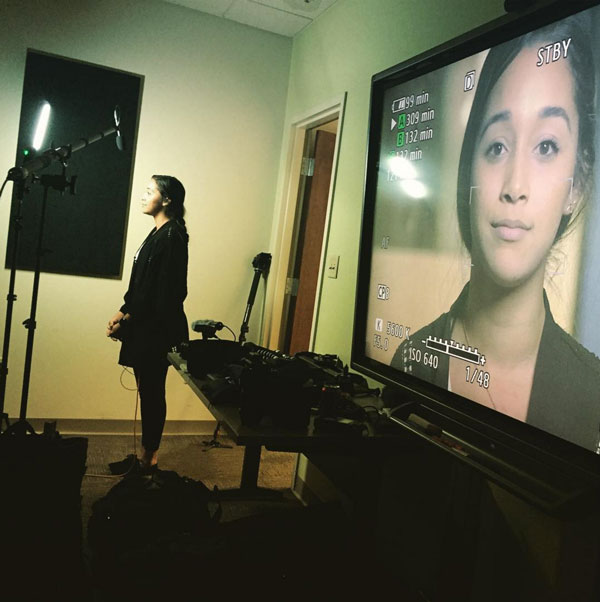
Looking to hire a video producer? We now do corporate video production in Minneapolis Minnesota.
So for someone just getting started in video production, it’s natural to assume the world of corporate filmmaking is a desolate pit of unhappy sell outs who wouldn’t wish their career on any talented up and comers.
The truth is, shooting corporate video is the most plausible way to make a living from video production. But it doesn’t have to be all about the money part. Actually, we find it to be incredibly gratifying, perhaps even more so than documentary filmmaking. Why?
Because in corporate video, you set all the rules. The kinds of videos you want to make, within an industry or line of business that you’re interested in, and using the video production equipment that you enjoy using.
So when someone says they’re dissatisfied with their current work in corporate video, it’s most likely because they have fallen into a spiral of making videos that they find more and more boring, for clients who are harder to work with, and using equipment that makes the whole process frustrating.
No wonder the freedom of creative commercial production, or traveling documentary work, or even fictional narrative films seem all the more exciting than corporate video.
When we make the initial phone call, we don’t begin the conversation with, “What are you hoping to achieve with this video?” That question is useless, and we’re not sure why anyone asks that.
The goal, always, is to make a promo video that can be used in some way to help a business. What other reason is there?
Video Production Services: Eliminating the Mystery
What is Corporate Video Production?
The aim of this article is to present a way to make an independent living producing amazing corporate videos, and the methodology and philosophy that makes it profitable. And similarly, a corporate marketer can read this article to learn how to better approach a corporate video production.
You may notice that the gear recommendations further down in this article have some inherent similarities to our documentary filmmaking equipment article, partly because we produce videos in both documentary and commercial worlds, and so some of our gear and strategies are applied to both types of work.
But where documentary production depends on capturing the most amount of footage as possible using the most efficient equipment available, corporate video depends on knowing precisely what you want to shoot before the day of production, and using gear that gives you world class results without requiring major crews and budgets.
Corporate Video Production vs Other Video Types
First, let’s do a quick summary of what a contemporary corporate video is and what it isn’t. At a basic level, it’s a video made for a business of any size, for the purposes of either external promotion, or internal communication or training.
The videos can be any length, featuring any form of information expression, such as an on-screen subject delivering a scripted message, an interview-driven story, text presentation on the screen, or a Voice of God narrator. The visuals can be a series of A-roll and B-roll sequences of your subjects, along with possible animation or graphics, or even scripted or acted visuals that help to convey the message.
So is it like a commercial? Well, yes and no. Creative advertising doesn’t really fit under the umbrella of corporate video production. If you want to get into 30 second TV commercials or short-form creative videos sponsored by major brands, starting your own corporate video production business may not be the best approach.
Typically commercials are produced by agencies who put together a team of creatives, technical crew, and specialists such as camera operators or a Director of Photography.

Sometimes your corporate video productions resemble commercials more than documentaries
You may very likely produce a commercial - possibly even an exceptionally creative one - for some of your corporate clients. Or your business might get hired by an agency to serve one of the specialist roles on a commercial production. But for work where you produce, shoot, and edit your client’s promo video, often the video style will be a little more down to earth than a Superbowl ad.
So is it like a documentary then? The style of production and shooting can definitely resemble a documentary, in that there are still real people involved, and you still have to hustle to frame and capture shots on the fly, as well as interview or script your A-roll narration.
But the objective and approach is a lot less journalistic than a documentary. Your job is to promote a business to the outside world, or help explain a certain part of the business’s story to an internal audience, using whatever means that make sense, such as feeding lines to your interview subject or having employees act a scene out.
If it’s promotional in nature, then do nonprofits, churches, or schools fall under the banner of corporate video production? Here’s where we think the term “corporate video” begins to confuse people, and where “promotional video” or “promo video” should really be used in its place.
Yes, all of the above can be thought of as corporate videos. Even a Kickstarter campaign falls under this category. Or a behind-the-scenes video telling the story of how a fictional feature film was made.
Corporate video production pretty much spans the widest gamut of video styles on the planet. It includes lecture recordings and event videography, Powerpoint-driven instructional video, highly technical industry work, equipment demonstrations, you name it.
So it’s true, a large part of what we call corporate video production could very well be something you personally are not that into.
The Digital Filmmaker definition of corporate video
For our corporate video production company, we define the kind of promo video we regularly produce as follows:
A corporate or promo video is at its core a documentary style production, with interviews providing the narration and B-roll of subjects performing related actions, but with careful planning and deliberate video execution, and with the promotional message guiding all the decision making.
For a more thorough article on the differences between many video types, including corporate video production, check out our article on video production services.
How to make a Corporate Video Production not boring
You get hired based on the work you’ve already done. So if the last few videos you made were all hour-long boring presentations for a company that makes plastic widgets, then most likely you’re known for the person who makes that kind of video and you’ll get hired to do it again.
If you are interested in that kind of niche video production, then your video production company is going to be wildly successful because there probably aren’t many other video producers specializing in your niche.
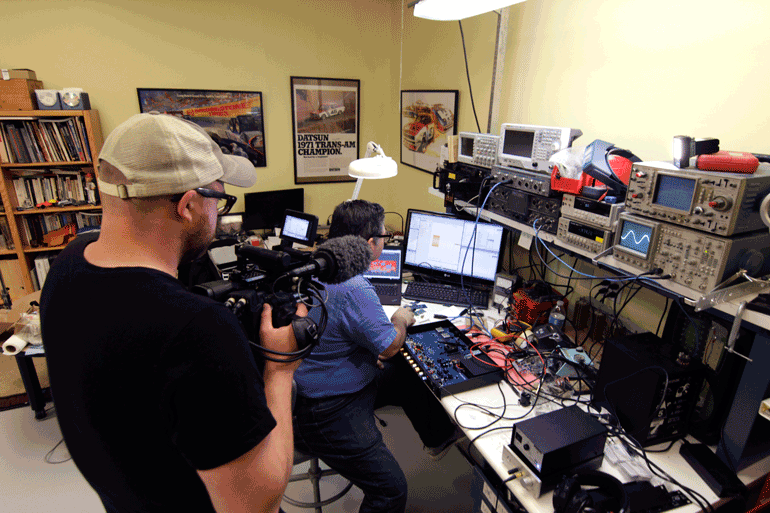
If, however, you want your video production company to have a more broader appeal, and you want to make videos that are inspirational, authentic, and genuinely tell the story of a business, group, or individual, then make that the kind of video you’re known for making. And you’ll start to get hired to make more of them.
And if someone still comes along and asks you to make a dry, half hour widget demonstration, maybe you politely decline, or maybe you take that job anyway to pay today’s bills, and you make it the most engaging, inspirational half hour demonstration of widget technology you can.
Because at the heart of every video there are still people, and people are always interesting, and good video production can make people a lot more interesting.
In summary, you choose the kind of corporate or promo video you want to make a living producing. And with that kind of control, your video production business becomes an extension of your personal creative desires and filmmaking interests.
Video Production Services: Eliminating the Mystery
How do you actually make a sustainable living with corporate video production? The first few years follows a very simple circle of growth.
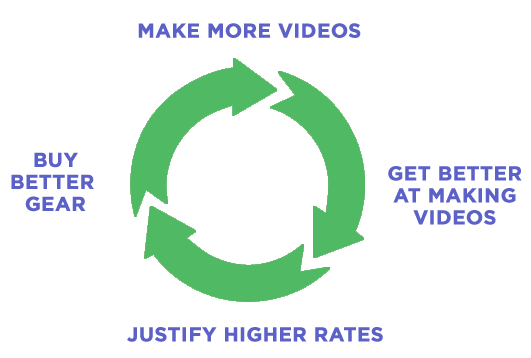
You work on making more videos faster, while steadily increasing the quality of your output, so you can demand higher prices, which help you buy better gear, which allows you to make more videos even more efficiently, while also giving you more quality results. Rinse, lather, repeat.
How do you get to a point where you can make more videos and quicker, without sacrificing quality? You have to be able to transform something that is inherently creative, subjective, and to most people a totally mysterious process, into a well-oiled operation that has predictable schedules with guaranteed results.
Essentially you have to remove the big question marks out of the process of filmmaking. What is this even going to be, or look like? What’s the story? Who is talking? What are the visuals? How long will it take? How much will it cost?
You have to be an expert in knowing exactly how to make a certain type of promo video, time and time again, with predictability, even though the client, subjects, location and message will never be identical.
How Corporate Video Production Clients Hire
Most corporate video production clients have little idea how a video is made. They might have seen a video that they liked, or maybe they’ve hired someone to make a video for them in the past, but they are not experts in the art and science of video production.
To them, it’s mostly a big question mark, but do you think anyone will admit they’re clueless about what a video is or how much it costs when they contact you for a quote?
Of course not. Most likely they’ll say they’re looking to make a certain type of video, with maybe one or two very specific details to guide the initial conversation (or to set themselves up as the person in charge), and then they’ll ask for an immediate quote.
If you want to make the initial conversation with a client easier, we've recently written up a long infographic and article on all the different kinds of video production services that clients request.
From: Susan in Marketing
To: Nonprofit Video Production Services Inc.
Hi there, we’re looking to make a 7-10 minute video about our organization, to show at a fundraising event in 3 weeks. We have some photos already, and our CEO and board of directors can provide all the talking points. How much would that cost? Thanks!
For example, you might get a message that says, “Hi, we’re looking to make a 7-10 minute video about our organization, to show at a fundraising event in 3 weeks. We have some photos already, and our CEO and board of directors can provide all the talking points. How much would that cost? Thanks!”
Based on that amount of information, can you estimate the precise amount of time you’ll need to shoot, plus the number of hours you’ll need to edit, what video equipment you’ll use, what the story will look like, what visuals you’ll need, and how to ensure you quote a reasonable amount that will get you hired (but still make you a profit)?
If you’re at the receiving end of that email, and you can’t visualize exactly what the video could look like and what you would need to produce it . . or if any part of the filmmaking process is still a question mark for you . . . or if you go into this project assuming that the client knows more about how to produce a good video then you do, then this process is going to be a frustrating experience for either you or the client, or both.
We get this kind of request all the time, and while a follow up phone call is always encouraged, to get more details about the project before you spit out a number, we already know the cost and project details before we make the call.
How Much does a Corporate Video Cost?
For example, in this case we know that a 4-6 minute video is a lot more engaging to audiences than a 10 minute video (unless it’s a really kick ass 10 minute video, which might be hard to do in a 3 week turnaround).
And for a 4-6 minute video, we know that interviewing 3-4 subjects and weaving their interviews together makes for the most effective video and use of people’s times.
We also know that interviewing a volunteer, client, donor, or a low-on-the-totem-pole staff will always make for a more inspirational video than hearing the CEO or board of directors give their practiced marketing talking points.
Our standard promo video
* 4-6 minutes long * 3-4 subjects interviewed * 6-12 sequences at different locations * 2 days to shoot with a crew of two * One week to edit
We’ll need one quiet location and about 4-5 hours for those interviews, and the rest of the time we’ll want to capture the 3 subjects in a variety of scenes for engaging and cinematic B-roll.
And finally, we know up front that it will take us two days to shoot, with two of us on crew, and about a week to edit. Our corporate video production kit is already packed with the video equipment we’ll use for this shoot.
When we make the initial phone call, we don’t begin the conversation with, “What are you hoping to achieve with this video?” That question is useless, and we’re not sure why anyone asks that. The goal, always, is a promo video that can be used in some way to help a business. What other reason is there?
We also don’t necessarily start with, “What is your budget?” As we explained above, we already know what it’ll cost for us to produce this video. And knowing exactly what it takes for us to do this kind of video, we also eliminate the whole mysterious question mark of pricing our videos.
Quick Tip: Eliminate the randomness or mystery behind your pricing. Set a general day or hourly rate, and create budgets according to your estimated shoot and edit times.
Your clients will appreciate the transparency and simplicity, rather than giving them zero information about cost breakdown, or worse yet, too much information with a line by line breakdown of all your expenses.
Our clients can see exactly what our breakdown of days to shoot and hours to edit are, so if their budget falls short of our fees, we can scale back the video to one shoot day, for example, and make a shorter video with less subjects and locations.
If the client has a bigger budget and wants to spend more, we can modularly increase the shoot days and offer additional video production services, such as splitting the 4-6 minute video into three 2-minute profiles of each of the subjects, or creating a series of 30 second teasers for their social media campaign.
But the point is, we eliminate the mystery of video production, how it’s made, what it’ll look like, and how much it costs. And that way we make sure our videos are always as good or better than the last one we made.
Whereas if you assume the client knows more about how a good promo video is made, then you’ll very easily end up making a 10 minute boring CEO talking head video, with photos as your primary visuals, and it will have a lower budget (yet you’ll work even harder revising the video 20 times because nobody is that stoked about how it turned out). And then somebody will see the video at the fundraiser and they’ll hire you to do the same thing all over again.
How to make a corporate video production go well
Now that you’re set on making a certain kind of promo video - say, a 4-5 minute engaging business story that promotes a new product but with an emotional plea to the audience - how do you make sure you can actually achieve that on every shoot?
Just like knowing how to envision a video and its costs long before you take a job, being able to walk into any shoot with the confidence that you’ll get what you need - under any circumstance - is an essential skill.
You can look at each shoot as a variation of a formula. For example, you need an interview (or 2 or 3), at least three sequences per subject (preferably in 3 different locations or even within different areas of a house or building), and some time to shoot the product.
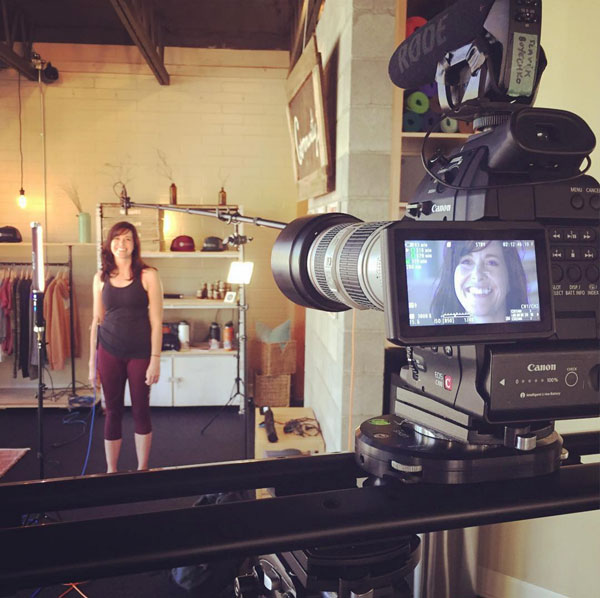
So when we start to plan our shoot, we know exactly the components that will make for a video shoot that we are confident we can edit into a great video.
In our phone call we’ll ask questions like:
- Can you identify a few subjects who would be interested in telling their story about how the organization has impacted them?
- Is there something happening in the next couple weeks that would make that particular day the best time for us to shoot?
- What are some other things the subjects could be doing that we could capture?
- Is there a place we can interview without distraction for a few hours? What does that place look like?
- What are other areas in the building where we might shoot some action?
Whereas in a documentary you’re fairly limited to how much action you can act or recreate, in a corporate video production you can do whatever you and the client is comfortable with, as long as it’s actually helpful for the video.
For example, if you’re shooting a wine maker, it’s perfectly acceptable to ask him or her to walk through the vineyard a few different times, pick up and taste the grapes, or do whatever is necessary to get the B-roll you need. In a documentary, on the other hand, sometimes you only get one shot at capturing those real life moments.
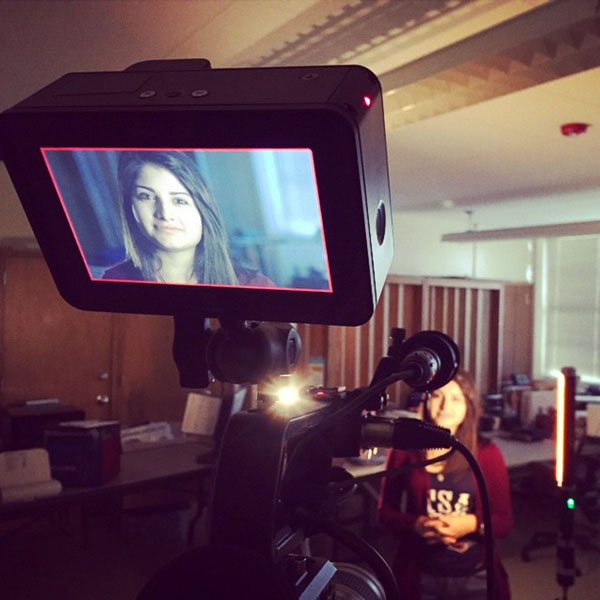
So don’t be afraid to ask your subjects to repeat an action, or try it a different way. During an interview, you can ask a question a few times, maybe in different ways, in order to get what you need.
You can even tell the subject the kind of answer you’re shooting for, so they know what they should say (but in their own words).
As a last resort, you can certainly feed lines to your subject, but it only works for very short phrases.
In many ways, a promo video shoot can be a lot funner and simpler than a documentary, because the rules of production are less rigid, and you end up shooting only what you’ll need for the final video, rather than a large amount of throw away footage that may or may not be used.
But don’t forget you’re dealing with real people, most of whom have no experience appearing in a video. With a documentary, you can easily explain to your subject that their job is to simply go about their business, pretend like you’re not there, and you’ll aim to capture as much as you can around their schedule. And in the interview, their honest, unprepared answers are exactly what you’re looking for. All in all, it’s an arrangement that is easy to understand for the subject.
In a corporate shoot, however, the line becomes a lot fuzzier as to who is directing (you or the client), how much the subject should act or memorize a message, is the video about the business or about the person? It’s really easy to frustrate everybody very quickly.
Quick Tip: The key to making authentic and compelling promo videos about regular people is to prevent them from freaking out.
Lights in their living room, a big camera on their face. "Do you have an extension cable around? Can you re-do that action again? Try to act natural."
Before you know it, they freeze up or become tired, and their interview and action sequences will be much less natural.
Here’s our recommendation, based on many awkward experiences early in our careers. The way to ensure you get the best interview and B-roll, while providing your subject and client with a positive experience, is to not clue them into any of the problems and stresses running through your head. They’re paying you to figure everything out. And remember, they don’t know anything about how video production is done.
Once the subject feels the pressures of production, or becomes uncomfortable or overwhelmed - once they feel like they have to “perform” for a video rather than just be themselves - there’s not much you can do to save the video. It will be difficult to watch.
So avoid burdening your subject with the production details. Don’t ask them to stand in place for an hour while you fiddle with the lights.
Don’t tell them your microphone cable broke and you’re not sure what to do. They’ll wonder if they’re doing something wrong.
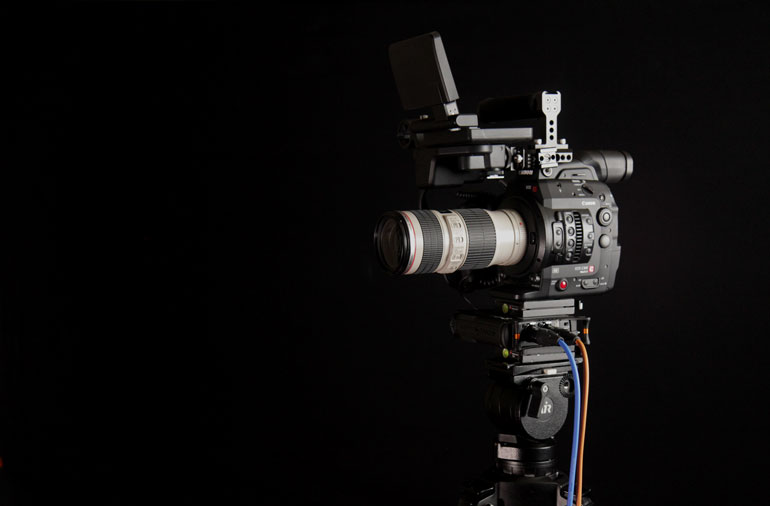
You're doing great, Joe!
And if their interview is not going great, instead of telling them they’re doing terribly, make it your personal goal to figure out how to get better responses by asking the questions differently.
And if the interview location they selected is not great, you know how to quickly pivot and ask them to help you find another location. “Why, is there a problem?” they might ask. No, there’s just some air handling noise or lights in the first room that is a little off, so maybe we can find a slightly better place, it’s not a big deal.
Or if they don’t have any action they can perform, you have some suggestions already, like maybe walk somewhere, have a (slightly acted) conversation with a colleague, work on a computer, write some notes, drive a car - these are all action sequences that could fit in just about any promo video.
Essentially, your job is to make your subject and client feel like everything went really smoothly, rather than coming away with the perception that something was amiss. And then when you edit the project, no matter how difficult it is, you still want them to see the whole process as a cake walk.
In the end, the better you become at preproduction, day of production, and editing, the more your final videos will look like everything was super easy. And that’s the ultimate irony. Because the easier it looks, the more years of experience and talent it takes to achieve that level of production.
Case Study: A Bird Festival Promo Video That’s Not About Birds
Take a look at this video we produced a couple years ago:
The video is about an annual bird watching festival in remote Cordova, Alaska. Cordova is a small fishing town unreachable by roads, but for millions of migratory shorebirds, it is the most important rest area on their highway journey across the globe.
There are amazing nature filmmakers out there who could make a very good video about these magnificent shorebirds. But the city hired us because they know we make videos about the people, in a way that can engage even non bird enthusiasts. More importantly, they’ve hired us in the past and knew we could get this video done without creating additional work or stress for them, which is essential when so much is riding on a 4 day festival.
If you watch the video, you’ll see it’s not about the birds at all. It’s about people’s hopes and dreams, and about how the birds represent everyone who chooses to live in this tiny remote town. From the outside, it looks like a smooth production that reflects our current style of corporate videos. The video is under 6 minutes, it features 4 subjects telling their personal stories, and each story arc is both personal and also related to the overall cause.
If you were on the ground shooting, however, you would think the video was doomed.
When we flew in, we really didn’t have an idea of where we would be shooting or what the action sequences would be, apart from our subjects looking into binoculars, but hey, it’s Alaska, so there’s bound to be something spectacular. Unfortunately it rained the entire time we were there. There was literally nothing we could shoot that wasn’t out in the rain.
But we adapted, we quickly arranged a rough schedule for our subjects, we made on the spot interview locations work, we shot outside during the brief windows when it wasn’t pouring rain, and in the end we made an Emmy-nominated video that our client was thrilled with.
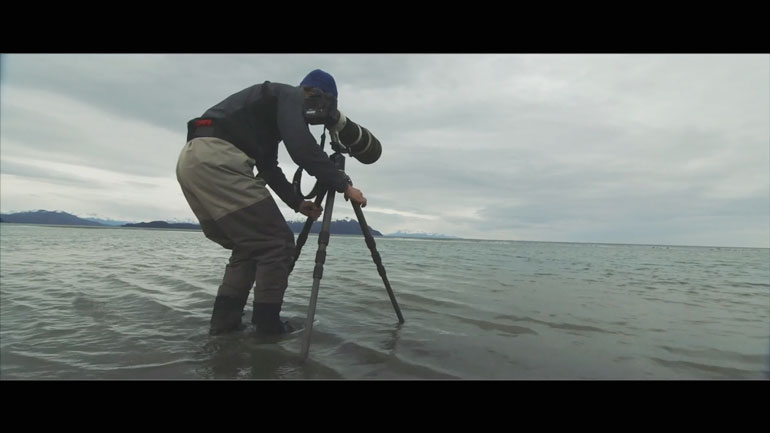
Here’s the point: nobody, not the subjects, not the city, not the festival managers had any inclination that the production was challenging. We kept those pressures to ourselves.
And as a result, the city and nearby organizations have hired us to come back for a variety of other projects. Rain or shine.
Viral Video Production
At some point during your video production career, the question of “return on investment” will come up, especially if your core product is the promo video. And with any web video, the easiest metric in the world is the view count.
Are you promising results as part of your pitch? If so, you probably can’t predict if sales will rise or if the company brand will increase in value. But you do have some degree of control over how many people will see your video.
The question is, do you want viewcount to be an integral part of your video production business? Are you getting hired to produce a really good promo video, or are you getting hired to get audience engagement up in some way or another?
The truth is, no matter how great at video production you are, these kinds of documentary style promo videos aren’t ever going to reach platinum views. They’re not designed to maximize audience reach. In fact, just the opposite is true.
These kinds of promo videos are meant to create an intimate, emotional connection with a viewer, and as a result, the perception of the business is positively impacted, one viewer at a time. That goes for any small or large corporation, nonprofit, individual or group who commissions a promo video.
Ideally, a really corporate video will be so engaging that people will share it with their friends, family, and peer networks. Other than that, the only way to ensure a video gets viewed is to pay for it. The good news is social media is basically built around videos these days, so promoting, boosting, or sponsoring a video ad is quite easy and affordable.

So the next time a client asks about viewcount, you can suggest effective ways to pay for views that will guarantee eyeballs. Other than paying for ads, however, your only alternative to guaranteeing any number of views is to learn to make your videos go viral. Maybe that includes a cat, or a street prank. If you know the secret to ensuring a video goes viral, while promoting a brand in some way, you should probably be making Superbowl commercials for soda companies.
For the rest of us, we don’t produce viewcounts. We produce really great videos.
Corporate Video Production Equipment
If you’ve already read our article on documentary video production equipment, you’ll know that there’s a law of diminishing returns when it comes to video equipment. You get better results with more expensive and sophisticated equipment, but at a certain point, the gear starts to take over and your productivity and profits start to decline.
Much of what we recommend for a highly portable, efficient, and affordable documentary filmmaking it, we also throw in our corporate video production bags. Our camera support, audio equipment, bags and cases, most of our lenses, and the more advanced gear goes with us on promo video shoots as well as doc shoots. But there are a few solid differences between the kits and how we use them.
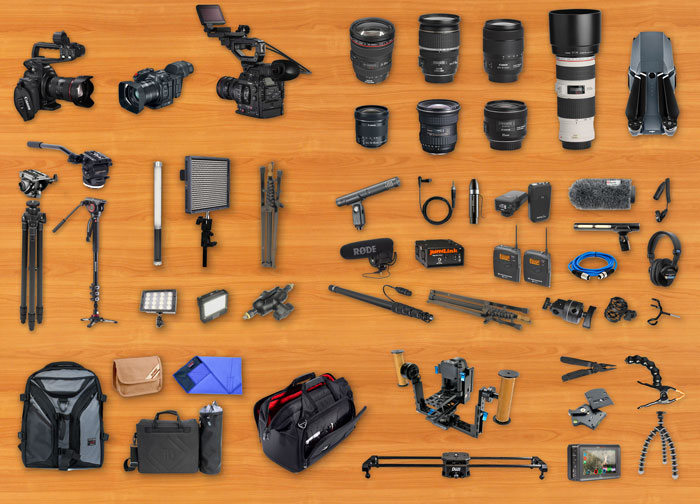
Our Documentary Filmmaking Kit
With corporate video production, your goal isn’t really to shoot a huge amount of footage, conduct extensive interviews, and then go back and try to edit a story out of what you shot. Instead, you’re carefully planning your shot list, overall message, and how your sequences will tie together, long before you begin to shoot.
So how does that affect what kind of video equipment you use?
Primarily, you need gear that is dependable over cheap and efficient. Because you’ll come away with a lot less shots in general, the footage you do get has to be solid, and you have to be sure you get it right the first time. Once you’ve settled on a video story and strategy with the client, you’re more or less committed to execute that vision, so if during your edit you realize half the day’s shoot had glaring problems, you can’t hide those issues by creatively editing a different story.
Secondarily, you need gear that gravitates more toward quality, rather than toward portability and efficiency. Partly it’s because in today’s world of DSLR consumer cameras, every business knows a friend or family who can make them a free or cheap video with a cinematic look. To give your work more value, your audio and visuals need to be above average.
As we wrote earlier in this article, 99% of people don’t know how videos are produced or why they cost as much as they do. So the perceptions that clients have of your work and its value rests entirely on your communication skills before the shoot, how you present yourself on the day of the shoot, and then finally, the video itself.
Realistically, you might be battling some preconcieved ideas of you and your business long before you get to the final stage of video delivery. So early communication style is very important, especially the confidence you exhibit during the preproduction or video planning process. But if your client chooses to come along on the day of the shoot - or perhaps they’re serving as one of your subjects - then you have an even bigger challenge ahead.
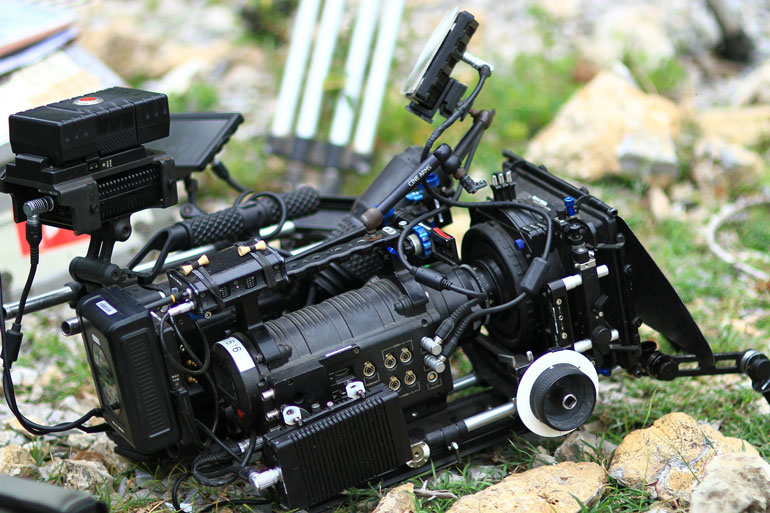
There's a camera somewhere in there
Imagine all the work you’ve done to get to the day of the shoot: painstakingly writing a great treatment, script, and emails communicating a vision for a really great video that everyone is on board with. And then you arrive with all of your equipment stuffed into a giant suitcase, which you then proceed to build up your camera rig with some 15mm rails, a follow focus, counter weights, an external monitor, an EVF, and batteries attached to the sides of a camera cage, all of which are towering over a little mirrorless camera you have wedged in the center of everything.
For your light kit you have a really crafty softbox you built out of cardboard and transfer paper, and holding your portable recorder with a built-in microphone is an especially long boom pole that’s brilliantly assembled from an old monopod, that now extends further than any boom pole you can buy on the market.
The truth is, your kit might have taken you years of clever rigging and smart shopping, and it might even perform as good or better than the unreasonably expensive video equipment it trumps, but neither your client, nor your subject, nor your audience cares.

Ideally they won’t even notice. But in the off chance your client does notice, we can guarantee they’re not going to be that impressed with your DIY gaff tape solutions.
In fact, the worse thing that can happen is your client starts to talk to you about his own little DSLR that is pretty much the same as yours. And then when something doesn’t work as it should on set, the client will start to wonder why they’re paying so much for you to shoot this when they have the same gear and can do it themselves.
So if you’re going to be a professional promo video producer, when you can afford better gear, buy the better gear, the stuff that you can depend on, will make your work better overall, and will not raise any feather of doubt in the eyes of your clients.
The Best Camera for Corporate Video Production
In the documentary filmmaking kit article, we recommended the Canon C100 for all types of documentary video production, and for corporate or promo video, we recommend the next level up, the Canon C300 mark II.
The C300 mark II is bigger, heavier, much more expensive, and is sometimes more of a pain to use.
For example, the batteries don’t last nearly as long as they do on the C100, the CFast media is insanely expensive still, and the sophisticated options (like color and profile settings) can be a little overwhelming to the everyday documentary shooter.
But for slower paced, more deliberate promo video productions, the C300 mark II is perfect. The image quality is simply astounding, especially around skin tones.

There’s 4k and slow motion recording, if your project requires it. The ergonomics make it so fun to shoot with, especially pared down without a lot of rigging.
In the end, the most important thing is the image quality, and with the C300 mark II you don’t have to spend a lot of time fiddling with color grading to achieve a beautiful image. You can ask any C300 owner and they’ll tell you, their clients love what they see.
Corporate Video Production Lenses
As for lenses, for the most part we stick with our typical lens kit of a Canon 17-55mm or Canon 24-105mm for our normal lens, a Canon 70-200mm f/4 IS for our telephoto and interview lens, and a Tokina 11-16mm or the super affordable Canon 10-18mm for the ultra wide. But because we have more time for our shoots, we can also choose lenses that are less practical for fast-paced doc shooting but deliver excellent quality for a promo video.
Lenses such as the Sigma 18-35mm f/1.8, which doesn't have IS and therefore wouldn’t be in our documentary filmmaking kit, are perfect in a corporate kit. Prime lenses such as the Canon 35mm f/2.0 IS are also great to use on promo shoots. And if you’ve ever wanted a reason to use cinema primes (but don’t shoot fictional narrative films), corporate videos are a great time to get them out.
Tripod, Monopod, Slider and Gimbal
Luckily, our pick for the best tripod, fluid head, and monopod still works with the heavier C300 mark II. As does the Cinevate Duzi V4 slider, which has a load capacity of something like 100 pounds. But sadly, our favorite brushless gimbal for the C100, the Letus Helix Jr., is a little bit too small for the C300 mark II.
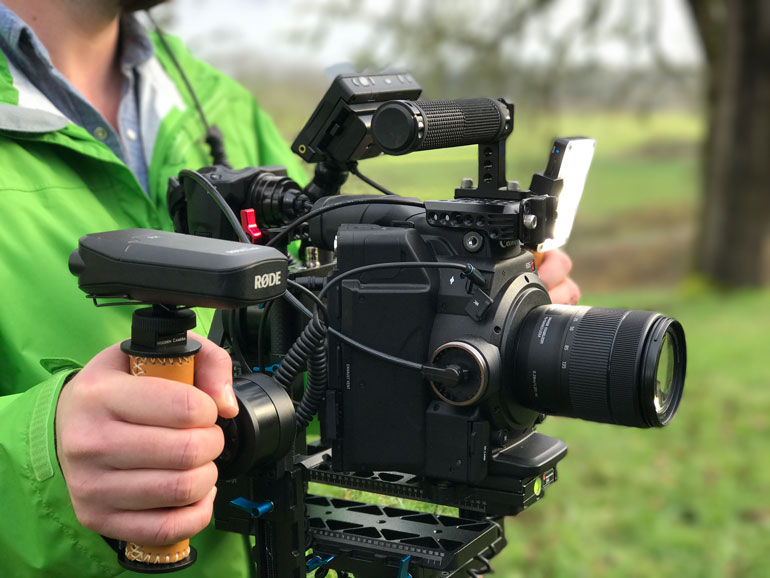
A Canon C300 mark II on a Letus Helix Standard
So if you want to take your C300 promo videos to the next level and shoot with a gimbal, you’ll need to consider a bigger gimbal such as the Letus Helix Standard. And once you add the heavier weight of the camera, the gimbal, bigger batteries and more rigging, it becomes a lot more difficult to hold for extended periods of time (unlike the C100/Helix Jr. which you can hold for hours comfortably).
There are support options for helping you hold a heavy gimbal rig, something like an Easy Rig, and then you have to consider additional gear that helps steady the gimbal for walking shots, such as a Flowcine Serene, all of which can add up to being more expensive than the camera itself. The law of diminishing returns applies here big time.
So we’ve figured out how to minimize the weight and rigging of the C300 mark II on the Letus Helix Standard, including using a super low light lens such as the Canon 10-18mm or Canon 18-135mm, and replacing the gimbal handle with the C300 handle for easier operation. We provide a thorough guide to this mod in our Letus Gimbals article.
For us, it makes more sense to bring a B-cam to corporate video shoots, to use entirely on a gimbal. You can use a much smaller and lighter camera with a wide lens, and just leave it on the gimbal until you need it. We review various options in our DSLR Gimbal article. But here's a hint, the DJI Ronin-S takes the cake. Check out our DJI Ronin S Review.
Teleprompter
One aspect of corporate video production that you may be unprepared for is the need for a teleprompter. They can get quite expensive, especially if you end up not using one all that much.
We’ve had great luck with the Pad Prompter, which has been around for a few years now. It’s designed for the 9.7” iPad, but we’ve tested it out and it actually works with the 12” iPad Pro too, which gives you more screen space for your script.
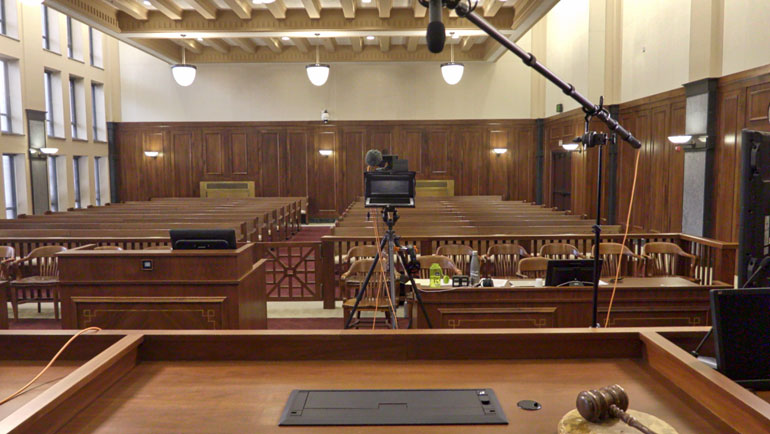
You’ll need to purchase a tele prompting app that you can use on both your iPad as well as your iPhone/iPod as your remote. We recommend the ProPrompter Studio, which has a simple GUI but is robust enough for many kinds of custom needs.
If you’ve never used a teleprompter before - whether that means running one, or reading one - you’ll want to give yourself plenty of practice in advance of your first shoot with it. The slightest change in speed or font size can mean the difference between a happy subject who delivers a great performance, to complete and utter frustration and a failed shoot. We’ve been there - it’s not pretty.
Interview Lighting Kit
At last, we come to the light kit. It’s incredible how many options we have for lighting products, competing for your primary three point light kit. In our documentary article we prefer lights that are extremely portable, over output or durability.
Here, the name of the game is the most amount of light you can buy for the money, built with reasonable expectation of durability, and the expectation that you’ll most likely diffuse your light through an umbrella, softbox, or silk diffuser.
Why are there differences between the two setups, when our final talking head shot will probably look quite similar? Partly it’s because we have more time to setup, which means we can use more sophisticated setups, but primarily it’s because in a corporate video production you need to be prepared to make any interview location look like a million bucks.
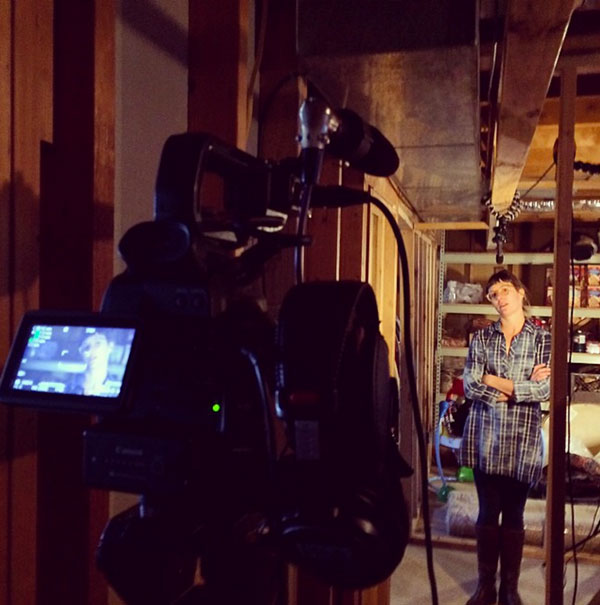
Filming in a Basement
In a documentary setting, usually you can get away with cutting corners - after all you’re the director and shooter (and probably editor), so you know what will be good enough (but maybe not perfect.
For example, you can conduct the interview in offbeat places like down in a basement, outside on an public sidewalk or in a park, or even in your hotel room. We’ve done that and more many times on many doc shoots.
When you have a corporate video client to appease, however, shooting in your hotel room is probably not going to fly.
So the terrible conference room they’ve reserved for you? That’s where you’re shooting the interviews. And it’s up to you to make it look great.
For our corporate video lighting kit, we recommend one of the Aputure Light Storm LED lights, either the Light Storm LS1S daylight version, or the Light Storm LS1C bi-color version if you prefer LED panels. Or the Light Storm COB120D if you prefer a highly flexible LED Fresnel with a variety of diffusion options.
Aputure Light Storm LS1S and LS1C LED Panels
The Light Storm panel is very solid and has immense light output for its size, and the quality of the light has a very high CRI value of 95+. You can power them with AC or batteries, and they have a convenient remote that allows you to adjust output and color while standing behind your camera and watching your frame.
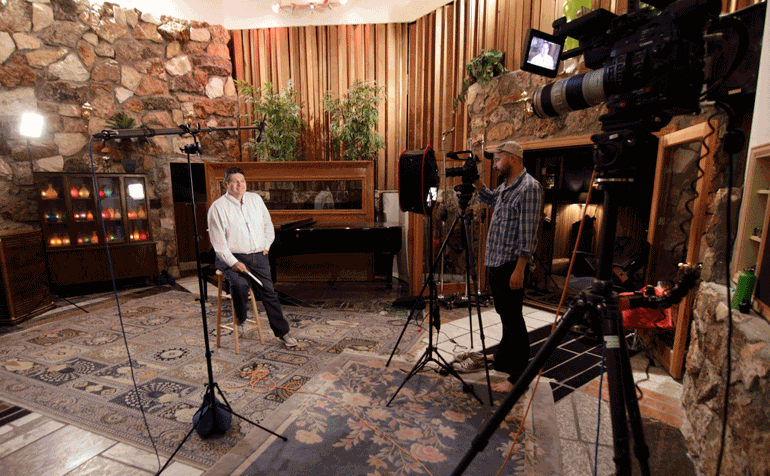
Shooting with the Aputure LS1C in a D-Fuse Softbox, and an Amaran 672W for a rim light.
The Light Storm panels have the power and feel of much more expensive LED 1x1 lights, but they’re still quite affordable. They are definitely nowhere near as portable as the Aputure Amaran lights (which we prefer for the documentary kit), but for promo shoots they’re perfect. In fact, combining the two types of lights for a 3 point kit is easy to do, since the Aputure remote can control all the lights.
If you’re having trouble choosing between the daylight or bi-color version, the daylight version has twice the output, but of course you’ll need colored gels for anything but a day rated white balance. In our experience, the bi color is more than enough light for indoor interviews, but it has difficulty competing against the sun in outdoor interviews. So if you plan on doing anything outdoors, the LS1S would be better. If you’re doing mostly indoor shoots, the bi-color is very convenient.
You’ll want to use some sort of diffusion for your key light, and the simplest solution out there is the D-Fuse Softbox. There are better and bigger light sources out there, but for us, the D-Fuse does a good enough job that anything more complex or expensive starts to have diminishing returns.
You can read more a more in-depth discussion on Aputure Lights.
Aputure Light Storm COB 120D LED Fresnel
If you want to go with a more flexible LED fresnel option, the Aputure Light Storm COB120D is as powerful as the LS1S panel (when the fresnel beam angle matches its 25 degrees), but it can also be adjusted from 14 degrees to 120 degrees. Shot through a diffusion scrim, or umbrella, or the Aputure Light Dome, it becomes a very powerful yet soft key light. It's also very powerful simply bounced onto the ceiling.
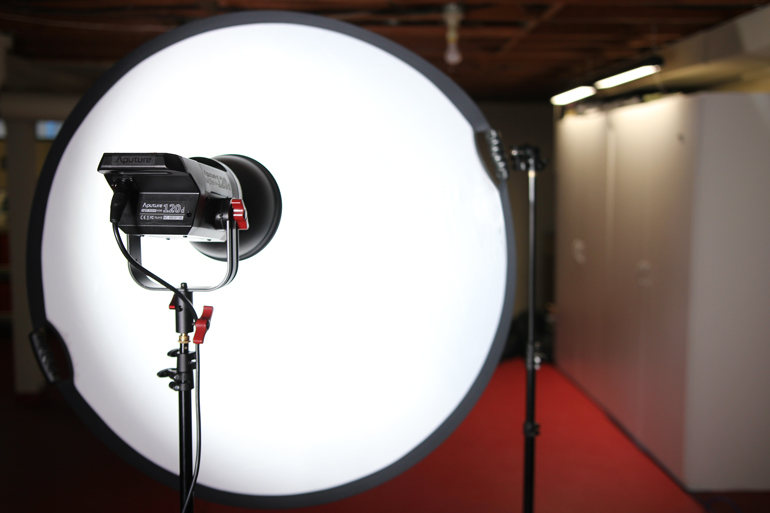
We do a full review of the Aputure COB 120D in this article. But more recently, Aputure has released the Light Storm 300D Fresnel LED, which is a complete game changer for corporate video production, especially for outdoor interviews. Here's our in-depth review of the Aputure 300D.
What's Next For Your Corporate Video Production?
That’s our wrap for this long article on corporate video production. We hope it’s helpful to you and your video production company. If you want to share your tips, as well as list of gear you like to bring on your corporate video shoots, please contact us and we’ll publish your tips here.
Are there aspects of corporate video production you want to learn more about? Let us know what other topics you think we should feature on this site. Send us an email and we'll get back to you as soon as we can.
Thanks for reading!